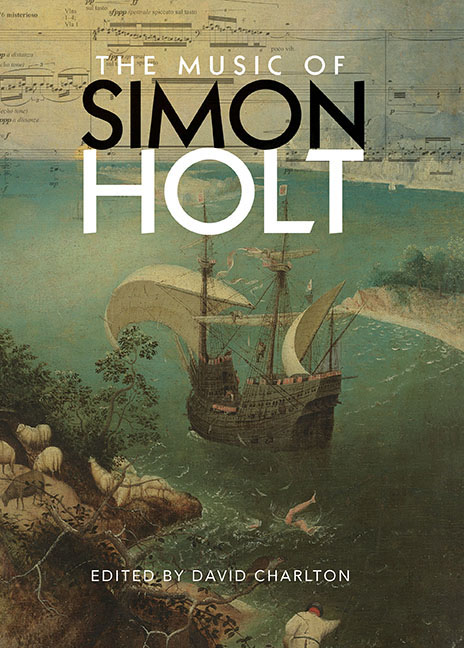Book contents
- Frontmatter
- Contents
- Figures and Tables
- Contributors
- Preface and Acknowledgements
- Abbreviations, with a note on recordings and scores
- Introduction Memories of Magical Moonlight: Simon Holt's years as a composition student
- 1 Duende y Duelos: The Andalusian spirit in the Lorca settings
- 2 An Interplay of Passion and Spirit: The Nightingale's to Blame
- 3 Images in Sound: Movement, harmony and colour in the early music
- 4 Myth and Narrative in 3 for Icarus
- 5 Sound, Sense and Syntax: The Emily Dickinson settings
- 6 Piano Music
- 7 Redefining the Cello's Voice: Musical agency in feet of clay
- 8 Performance and Reflections: Holt's music for oboe and cor anglais
- 9 Shaking the Bars: The Yellow Wallpaper
- 10 Listening to the River's Roar: Stance, texture and space in the concertos
- 11 Orchestral Works in Performance
- 12 Oblique Themes and Still Centres: A conversation between
- 13 Sketching and Idea-Gathering
- 14 Art, Conceptualism and Politics in Holt's music
- Appendix A Overview and Catalogue of Pieces
- Appendix B Texts by Simon Holt for Raju Raghuvanshi is a ghost and The Legend of Melusine
- Bibliography
- Index of pieces by Simon Holt
- General index
11 - Orchestral Works in Performance
Published online by Cambridge University Press: 01 September 2018
- Frontmatter
- Contents
- Figures and Tables
- Contributors
- Preface and Acknowledgements
- Abbreviations, with a note on recordings and scores
- Introduction Memories of Magical Moonlight: Simon Holt's years as a composition student
- 1 Duende y Duelos: The Andalusian spirit in the Lorca settings
- 2 An Interplay of Passion and Spirit: The Nightingale's to Blame
- 3 Images in Sound: Movement, harmony and colour in the early music
- 4 Myth and Narrative in 3 for Icarus
- 5 Sound, Sense and Syntax: The Emily Dickinson settings
- 6 Piano Music
- 7 Redefining the Cello's Voice: Musical agency in feet of clay
- 8 Performance and Reflections: Holt's music for oboe and cor anglais
- 9 Shaking the Bars: The Yellow Wallpaper
- 10 Listening to the River's Roar: Stance, texture and space in the concertos
- 11 Orchestral Works in Performance
- 12 Oblique Themes and Still Centres: A conversation between
- 13 Sketching and Idea-Gathering
- 14 Art, Conceptualism and Politics in Holt's music
- Appendix A Overview and Catalogue of Pieces
- Appendix B Texts by Simon Holt for Raju Raghuvanshi is a ghost and The Legend of Melusine
- Bibliography
- Index of pieces by Simon Holt
- General index
Summary
EDITOR's INTRODUCTION
THIERRY FISCHER, the Swiss conductor, has to date programmed fourteen pieces by Simon Holt in various concerts over three continents. Of these fourteen, seven have also had their world premiere under his direction. Orchestras involved have been the Nagoya Philharmonic Orchestra (Japan), the Essen Philharmoniker and the Ensemble Modern (Germany), Utah Symphony Orchestra (USA), BBC National Orchestra of Wales, London Sinfonietta and the Royal Academy Symphony Orchestra. Fischer's earliest performances of Holt's orchestral music were in November 1998 when directing 3 for Icarus at the Huddersfield Contemporary Music Festival, when Zoë Martlew played solo cello.
The following texts are the result of email correspondence over twelve months. They have been re-ordered for publication so as to follow the chronological sequence of composition of the music discussed (seven pieces in all). This method of compilation permitted the involvement of others: thus, besides the editor (DC), Edward Venn (EV), Steph Power (SP) and David Beard (DB) offered the questions relative to those pieces about which they were writing in their respective chapters. Thierry Fischer's responses were later revised by him for publication.
QUESTIONS AND RESPONSES
DC: Is it possible to know an orchestra's opinion of the music they play, Simon's in particular?
TF: One particularity of Simon's music is that he writes, at the same time, very challenging and unbelievably simple music. This then immediately opens unexpected doors right from the first play-through. I remember that almost every time I conduct his music, I first perceive incredulity in the eyes of the musicians in front of me. One of the reasons is that the only thing Simon is listening to when he writes music is his deep urge to express beauty and/or pain, without looking at any method, trend, vogue, style or fashion. My experience is that players are often, at first, disturbed by Simon's music because he is bringing them to areas where the notion of beauty and simplicity isn't definable. After a few rehearsals, generally most of the musicians recognise they've gone through an experience they hadn't anticipated. Finally, I believe that the biggest strength of Simon's music is that musicians don't necessarily have an ‘opinion’ about his music. They have much more: a musical experience, creating possibilities in a world of impossibilities.
- Type
- Chapter
- Information
- The Music of Simon Holt , pp. 232 - 242Publisher: Boydell & BrewerPrint publication year: 2017

